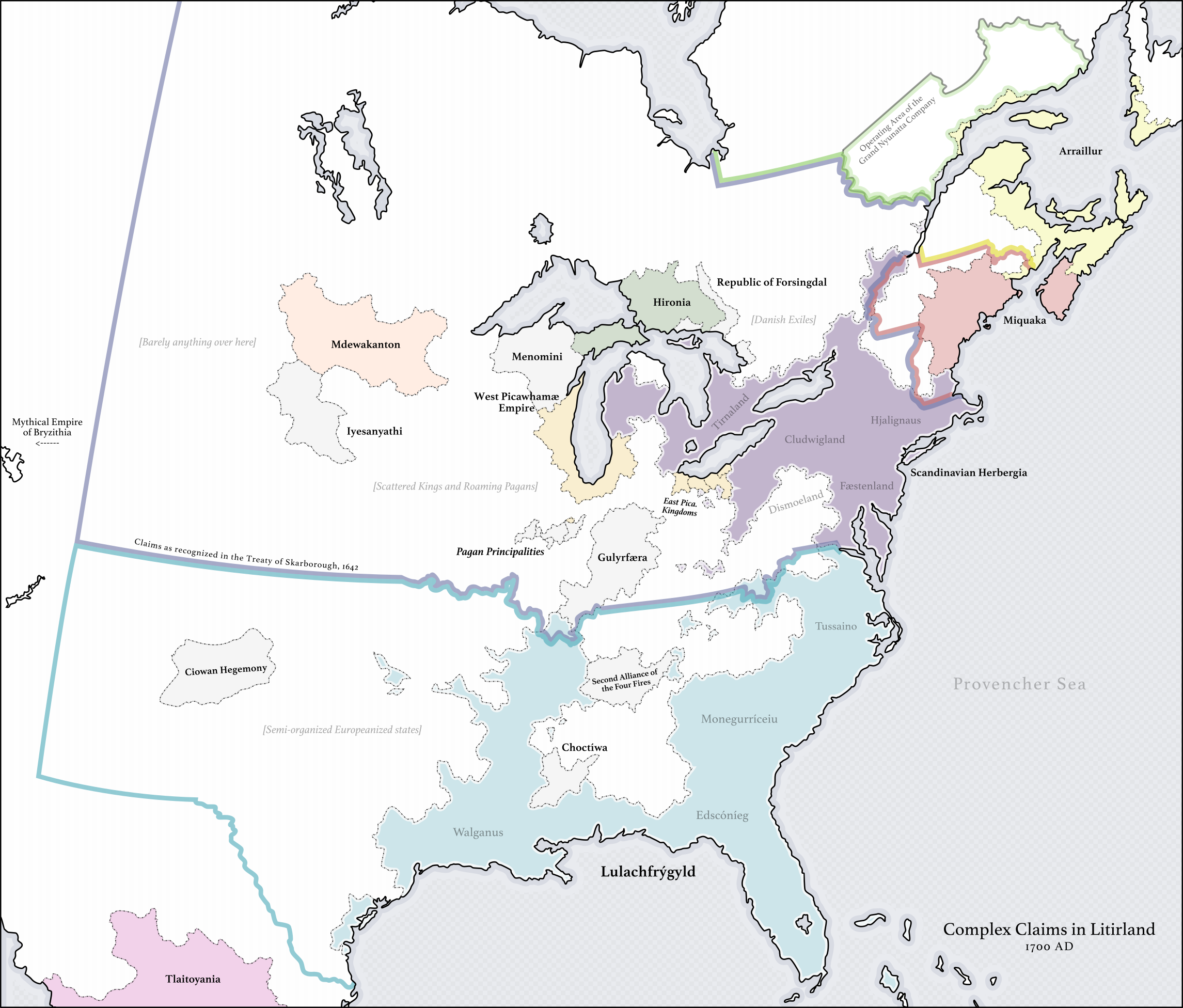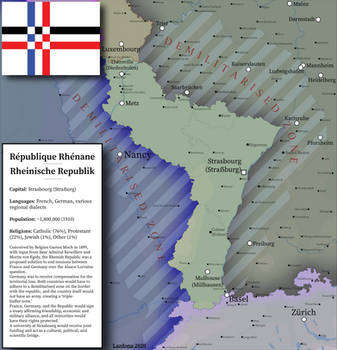Deviation Actions
Description
More from my "Lulach's Legacy" TL. ![]() Check out more right here: www.alternatehistory.com/forum…
Check out more right here: www.alternatehistory.com/forum…
Litirland in 1700 AD
Even with the Treaty of Skarsborough being put into action, there were still many groups content with not following it. The five main signatories, Arrailur, Nyunatta, Scandinavia, Miquaka, and Vinland (and maybe Umbúðir, if you had any reason to count that), were only five of around fifteen centralized nations on the continent. There were the Ashoqua (Mexica) and the Tique (Tlaxcala) in the far south, civilizations arguably more organized than Lulachfrýgyld before being taken over by the French and Chinese. Of course, besides the gold-filled superpowers that dangled their wealth in front of colonizers like a carrot on a stick, there were smaller, more modest kingdoms.
Two hundred years after the reign of N’aghan, the first king of the Picawhamæ, the empire fell apart in a spectacular civil war. At a time just after European contact, in what the Christian calendar would call the 1470’s, the Frygian kingdoms were occupied with much larger things than helping or hurting a country that didn’t matter much to them. They were busy fighting the same European kingdoms that would eventually prey on the remains of the formerly great tribe. Starting as early as 1422, tribal movements into the Picawhamæ capital of Tpukizes were causing some serious upheaval. Tpukizes originally began as a colony, but eventually became their capital due to being central in the empire (OTL Chicago). This only ended up making it easier to attack by other tribes, whose migrations ended up bringing down the elite. The Mascouten, Winnebago, and Kaskakia chiefs, all of whom used to be friends with their Picawhamæ emperor, revolted to overthrow the empire holding them down. However, they ended up moving into the homeland of the Picawhamæ instead of the capital, and many others did the same. Other tribes moved away from the capital. The Fox chiefs ordered a southward march into Frygian territory, hopefully escaping the oncoming massacres. The Mdewakanton and Yankton tribes both migrated west, to where they hoped would be slightly out of reach of Picawhamæ generals. What finally collapsed the empire wasn’t tribal migrations, it was religion. People in the east of the empire, like the Erie and Wenro (well, when the Wenro were a part of their empire, at least) had converted to the types of paganism introduced by settlers in what would become Herbergia. The other half followed some form of crude Christianity, most of it deformed by the original beliefs practiced centuries before. But, what was one religion might as well have been ten, as no one group seemed to agree on any part of the Bible with another. The Picawhamæ’s final king, hoping to appease everyone, declared one universal religion, created as a hope to combine any and all beliefs of the people, thereby strengthening the empire in its twilight days. Needless to say, people didn’t buy it. The homeland of the Picawhamæ was uprooted, a successor of the empire was declared in Tpukizes, and the rest fell into anarchy.
Decades later, maybe a century or so, the city-states that had formed after the collapse were finally forming themselves into consolidated entities. The Menomini Kingdom was one of the first to be established, as they didn’t move themselves around much during the civil war. They stayed in the same place, with the same religion, and were able to flourish because of it. The Huron, called the Hirons to European settlers in Litirland, were adversaries to the Picawhamæ for centuries, the Xiongnu to their China. After the collapse of the homeland, the Huron were able to form a more unified government, and expanded into new land. Next came the Mdewakanton and the Iyesanyathi, successors to the Mdewankanton and Yankton governorates respectively. All four of these new countries, plus the Tpukizesian Empire itself, paled in comparison to the military might of Herbergia (a colony whose power wasn’t even that large in the first place). They expanded outside of their five original provinces by taking advantage of the division, and set up new colonies on what they named the Danskjavlar Peninsula (Michigan).
Of course, with the expansion of the Scandinavians came some… issues. Some people were adverse to the strict conversion and treatment of the natives, especially since many were already politically and religiously “advanced” according to them. Others hated the Scandinavian way of life entirely, and wanted to escape to Litirland where they were free to practice things other than the Scandinavian brand of Christianity. So, in 1677, a Thyrenian Christian woman named Trine Forsingdal escaped up the Ibalhandia River, crossed over the northern reaches of Tirnaland, and founded her own republic on the edge of Lake Overskyetsø (OTL Lake Nipissing). By 1700, the small but growing republic was run by High-Regent Ejgil Elkjær, a Jew. Trine lived in a small house on the edge of the lake, sometimes stopping to make trips up the Overskyet River to trade with the Hirons. She was marched out of the city after being caught in a relationship with a female friend, and ended up sailing into Menomini territory where she was never seen again (however, recent evidence suggests she lived as a trader, potentially disguising herself as a guy to continue her relationship with her former lover until her supposed death in 1734). At least it was progressive for its time...
The last few stragglers were in the south, normally only independent because they refused to call themselves Frygian. Gulyrfæra was the largest of these countries, made up of a combination of pagans and natives annoyed with being constantly hounded by missionaries. The majority of its inhabitants were either Old English or Scandinavian, and almost provided a meeting ground for the two cultures to intermingle. In addition to Gulyrfæra, there were many other pagan principalities run by maniacal kings. Luckily, most had little to no power. Going even further into Frygian territory, there were still holdouts run by the groups the Frygians had overrun in their original expansion. The Second Alliance of the Four Fires, a successor to the short-lived military alliance of the late-1100’s, was made up of the Chessain, Tenise, Tacate, and Cheƿocia (the latter arguably being the most powerful). While not economically or militarily powerful, the Second Alliance was culturally one of the most influential in the region. They drew people from all over the continent with their promises of native liberation, and were admired for their ability to resist any advancement of Frygian settlers into their territory. The same went for the Choctíwa, a nation so close to the action that they were nearly completely Ældenglicized. And, finally, in the far west, there was the Ciowan (Kiowan) Hegemony, a confederation of people so far away from Europeanized civilization they had basically started an empire free of anyone else’s influence. There was of course contact, but it was something of a muddle as to when the Ciowans actually formed a civilization, and the first formal meeting of a Ciowan dignitary and a Frygian king was in 1698, when a supposed noble named P’ahyton (his exact title isn’t currently known, he could have been a general or the king himself) met with Glædwine of Firgenstréam to discuss trade deals over mashed Muscadines.



































